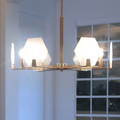The Scandinavian Design Style
Scandinavian design is a style of interior design that originated in the Nordic countries of Denmark, Finland, Iceland, Norway, and Sweden in the mid-20th century. This design philosophy is characterized by its simplicity, functionality, and connection to nature. The primary intention is to enhance daily life by emphasizing the interplay of form and function. A hallmark of Scandinavian design is the efficient use of space, often featuring open floor plans and multi-functional furniture. The favored color palette is predominantly neutral punctuated occasionally by soft pastels or bold accents. This creates a calming and harmonious atmosphere that mirrors the serenity of the Nordic landscapes.
Natural light is a cherished commodity, and interiors are designed to maximize its infiltration. Windows are often left unadorned or minimally treated to ensure that rooms are bathed in sunlight. The beauty of Scandinavian design lies in its restraint and clarity, creating homes that are not only aesthetically pleasing but also genuinely livable.

Scandinavian Style Architecture
Born from the historical context of the Nordic countries, this style emphasizes clean lines, minimalism, and an interplay of natural materials. Large windows are paramount, capturing as much light as possible during the shorter winter days, while also blurring the lines between indoor and outdoor spaces. The use of wood is prominent, not just as a structural element, but also as a surface material, bringing warmth and a tactile quality to the interiors.
Scandinavian architecture celebrates simplicity and clean lines.
Large windows are crucial, maximizing natural light and connecting indoors with nature.
Wood is extensively used, both structurally and aesthetically, adding warmth to spaces.
The designs are environmentally conscious, incorporating sustainable building practices.
Spaces are efficient and functional, often featuring open floor plans for versatility.

Scandinavian Style Materials
Wood, predominantly from abundant Nordic forests, is favored for its warmth, versatility, and timeless appeal. From pale ash to rich mahogany, each variety imparts distinct nuances to the design. Besides wood, materials like wool, leather, and natural stones are widely incorporated, echoing a tactile and sensory experience. Light, both natural and artificial, is cleverly manipulated through the use of glass and reflective surfaces.
Wood, especially pine, oak, and ash, is the foundational material in Scandinavian interiors.
Natural textiles like wool and cotton add comfort and texture to spaces.
Leather and hides, often in muted tones, provide an added layer of sophistication.
Natural stones, such as granite and marble, are commonly used for countertops and accents.
Glass, both in windows and fixtures, maximizes light distribution and enhances brightness.

Scandinavian Style Colors and Finishes
A foundation of neutral tones, like whites, beiges, and soft grays, create serene and inviting interiors. Pops of muted colors, inspired by the Nordic natural landscape, such as blues, greens, and earthy browns, are introduced to add depth and interest. Natural finishes, especially matte and muted, dominate the style, allowing the materials' authentic textures to shine through. Soft furnishings often sport patterns, but they remain subtle, infusing spaces with character without overwhelming the senses.
Neutral tones, predominantly white, gray, and beige, are foundational in Scandinavian designs.
Accents of blues and greens reflect the region's natural landscapes.
Earthy browns and wooden textures lend warmth and grounding.
Natural, matte finishes emphasize authenticity and simplicity.
Subtle patterns, inspired by nature or Nordic traditions, are incorporated in textiles and decors.

Scandinavian Style Furniture and Decor
Craftsmanship and clean lines are emphasized, with pieces made from light-toned woods like pine, oak, or birch. Sofas and chairs are both aesthetically pleasing and comfortable, often upholstered in natural fabrics. Décor is understated, focusing on enhancing the room's ambiance without overcrowding. Natural elements like plants, woolen textiles, and ceramics are prevalent. Functional items like storage units and lighting fixtures are also designed with an artistic touch.
Scandinavian furniture showcases clean lines and skilled craftsmanship.
Light-toned woods, such as pine and oak, dominate furniture pieces.
Comfort is paramount, with seating often upholstered in natural fabrics.
Décor items, including plants and ceramics, introduce elements of nature indoors.
Functional pieces, like storage and lighting, seamlessly blend utility with design aesthetics.

Scandinavian Style Lighting
Lighting fixtures are designed to maximize brightness while maintaining a sleek, minimalist aesthetic. Pendant lights, often in white or metallic tones, are popular choices, casting soft ambient illumination. Floor and table lamps with slender profiles and neutral shades are common, ensuring spaces remain cozy and inviting. Wall sconces and adjustable task lights prioritize practicality, ensuring specific areas, like reading nooks, are adequately lit.
Scandinavian lighting emphasizes warmth and brightness due to long, dark winters.
Pendant lights, often in neutral colors, provide soft ambient illumination.
Floor and table lamps feature minimalist designs with slender profiles.
Practicality is key, with task lights and wall sconces targeting specific areas.
The design approach blends sleek aesthetics with functionality in lighting choices.